Checkerbloom Sidalcea 'Candy Girl'
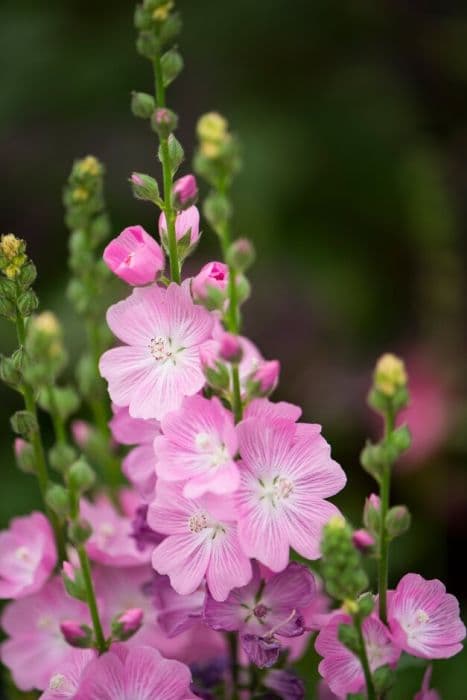
ABOUT
The Sidalcea 'Candy Girl' is a perennial plant that is often admired for its attractive, long-blooming flowers. It is a member of the mallow family, which is apparent in its flower shape. The plant bears clusters of delicate, cup-shaped flowers that come in a soft, pale pink color. Each flower has five rounded petals with slightly notched edges, giving them a subtly ruffled appearance. The blooms are borne on tall, erect stems that rise above a base of foliage. The leaves of 'Candy Girl' are lobed and somewhat resemble those of a geranium, with their deep green color and a slightly hairy texture, which makes them soft to the touch. These leaves are arranged in a rosette at the base of the plant, with some also alternately arranged along the flowering stems. Sidalcea 'Candy Girl' blooms in the summer months, offering a long season of color that attracts pollinators like bees and butterflies. The plant's overall form is upright and bushy, with multiple stems creating a clump of foliage and flowers that add a touch of softness to a garden setting. Its color and form make it suitable for various garden positions including borders and cottage garden schemes where it can be used to inject color amongst other flowering plants or green foliage.
About this plant
 Names
NamesFamily
Malvaceae.
Synonyms
Checkerbloom, Miniature Hollyhock, Prairie Mallow, Dwarf Prairie Mallow, Checker Mallow.
Common names
Sidalcea 'Candy Girl'.
 Toxicity
ToxicityTo humans
The plant commonly known as Checker Mallow 'Candy Girl', or more broadly, Sidalcea 'Candy Girl', is not known to be toxic to humans. Consequently, there is limited information on symptoms of poisoning since it is not typically considered a poisonous plant. Ingesting any part of this plant is not expected to cause significant toxic effects. However, it is always advisable to exercise caution and avoid eating plants that are not confirmed to be edible as individual reactions can vary.
To pets
Checker Mallow 'Candy Girl', the plant in question, does not appear on common toxic plant lists for pets, including dogs and cats. Therefore, it is not considered toxic to pets. There should be no symptoms of poisoning associated with the ingestion of this plant by pets. As with humans, while it is not typically considered a poisonous plant, it is generally recommended to prevent pets from consuming ornamental plants as they may cause gastrointestinal upset or an allergic reaction in some animals.
 Characteristics
CharacteristicsLife cycle
Perennials
Foliage type
Deciduous
Color of leaves
Green
Flower color
Pink
Height
3 feet [91 cm]
Spread
2 feet [60 cm]
Plant type
Herb
Hardiness zones
5
Native area
North America
Benefits
 General Benefits
General Benefits- Attracts Pollinators: Sidalcea 'Candy Girl' is known to attract bees and butterflies, supporting local ecosystems.
- Low Maintenance: This plant is relatively easy to care for, requiring minimal attention once established.
- Drought Tolerant: It can survive in dry conditions, making it suitable for water-conservative gardens.
- Long Blooming Period: It offers a long season of blooms, typically from midsummer to early fall, providing lasting color in the garden.
- Cold Hardy: Sidalcea 'Candy Girl' can withstand cooler temperatures, making it versatile for various climate zones.
- Aesthetic Appeal: With its pretty pink flowers, it adds a touch of elegance and beauty to any garden space.
- Perennial Growth: As a perennial, it returns year after year, diminishing the need for annual replanting.
 Medical Properties
Medical PropertiesThis plant is not used for medical purposes.
 Air-purifying Qualities
Air-purifying QualitiesThis plant is not specifically known for air purifying qualities.
 Other Uses
Other Uses- Crafting dye: The vibrant pink flowers of Sidalcea 'Candy Girl' can be used to create natural dyes for fabrics and yarns.
- Educational resource: This plant can be used in schools or botanical gardens to teach children about plant biology and the importance of pollinators.
- Garden design: The plant can serve as an excellent model in garden design classes, demonstrating how to incorporate native plants into decorative landscapes.
- Photography: With their striking blooms, Sidalcea 'Candy Girl' makes a great subject for botanical photographers and hobbyists seeking to capture natural beauty.
- Eco-friendly confetti: Dried petals of the plant can be used as a biodegradable alternative to traditional confetti at events.
- Art supplies: Pressed flowers can be used by artists in mixed media projects or to adorn handmade paper.
- Mood enhancement: The bright colors and attractive appearance of the flowers can help improve mood and create a positive atmosphere in any setting.
- Literary inspiration: This plant may inspire poets and writers looking for a floral muse or an emblematic image for their work.
- Culinary presentation: Though typically not consumed, the petals can be used to decorate and enhance the visual appeal of dishes in high-end culinary settings.
- Floral crafts: The stems and flowers can be incorporated into wreaths and other floral arrangements for decorative purposes.
Interesting Facts
 Feng Shui
Feng ShuiThe Checker mallow is not used in Feng Shui practice.
 Zodiac Sign Compitability
Zodiac Sign CompitabilityThe Checker mallow is not used in astrology practice.
 Plant Symbolism
Plant Symbolism- Delicate Strength: Sidalcea 'Candy Girl', commonly known as the Checkerbloom, often symbolizes the delicate nature of beauty paired with an underlying strength, reminiscent of its ability to grow in various conditions while still maintaining its soft, attractive petals.
- Femininity: With its soft pink hues and gentle appearance, Checkerbloom is often associated with feminine energy and qualities such as grace, gentleness, and tenderness.
- Youthful Charm: The vibrant and playful colors of the Checkerbloom's flowers convey a sense of youthfulness and joy, making them symbolic of the innocent charm of the younger years.
- Love and Attraction: Similar to many other flowers with pink tones, the Checkerbloom can represent romance, subtle attraction, and the blooming of new love.
- Native Integrity: As a plant that is native to certain regions, the Checkerbloom symbolizes natural beauty and the importance of preserving native ecosystems and the integrity of local flora.
 Water
WaterChecker Mallow, commonly known as 'Candy Girl', prefers evenly moist soil and requires regular watering. Water the plant deeply once a week with about 1 gallon per square foot, adjusting for rainfall and ensuring that the soil doesn't completely dry out between waterings. During hot, dry spells, additional watering may be necessary to maintain soil moisture. Overwatering or allowing the soil to remain waterlogged can lead to root rot, so ensure good drainage. During winter, when the plant is dormant, reduce watering frequency.
 Light
LightChecker Mallow thrives in full sun to partial shade. It performs best when it receives at least six hours of direct sunlight each day, so placing it in a spot where it can enjoy the morning sun and some afternoon shade is ideal. An area with bright, indirect light for the remainder of the day will ensure the plant's health and flowering.
 Temperature
TemperatureChecker Mallow is hardy and can tolerate temperatures as low as 20°F but prefers the range of 60°F to 70°F for optimal growth. Extreme temperatures beyond these thresholds can stress the plant. The ideal temperature conditions for this perennial would be moderate climates with few extremes.
 Pruning
PruningPruning Checker Mallow is essential for maintaining its shape and encouraging bushier growth. It should be pruned in early spring to remove any dead or damaged stems and to shape the plant. Deadheading, or removing spent flowers, will promote continuous blooming throughout the season. Prune again after flowering to tidy up the plant and prepare it for winter.
 Cleaning
CleaningAs needed
 Soil
SoilChecker Mallow 'Candy Girl' thrives in well-draining, fertile soil with a pH range of 6.0 to 7.0. A mix of garden soil, compost, and a portion of perlite or sand would create an ideal environment for this plant, ensuring both nutrition and adequate drainage.
 Repotting
RepottingChecker Mallow 'Candy Girl' does not require frequent repotting and can be done every 2-3 years or when the plant outgrows its current container. Spring is the best time for repotting to minimize stress on the plant.
 Humidity & Misting
Humidity & MistingChecker Mallow 'Candy Girl' prefers moderate humidity levels but is quite adaptable. An average room humidity of about 40-60% is suitable for this plant, avoiding excessively dry or overly humid conditions.
 Suitable locations
Suitable locationsIndoor
Provide bright indirect light, moderate water, and well-draining soil.
Outdoor
Plant in sun to part shade, in well-drained, fertile soil.
Hardiness zone
5-9 USDA
 Life cycle
Life cycleThe Checkerbloom 'Candy Girl' begins its life cycle as a seed, which germinates in spring when soil temperatures and moisture levels are suitable, leading to seedling development. The seedling's root system establishes itself in the soil, while the stem and leaves grow towards the light, developing into a young plant. With adequate sunlight, water, and nutrients, the young Checkerbloom plant matures and produces bushy foliage followed by tall flower spikes adorned with pink flowers typically in late spring or early summer. After pollination, often by bees and butterflies, the plant sets seed in the form of small capsules, which eventually dry and release seeds for the next generation. Throughout the growing season, 'Candy Girl' Checkerbloom can undergo vegetative growth, spreading through rhizomes to form clumps. The plant enters dormancy in the fall and winter, reducing aboveground growth, but the root system remains alive, ready to resprout come spring.
 Propogation
PropogationPropogation time
Spring-Summer
The Checker Mallow 'Candy Girl', a perennially delightful plant in gardens, is most commonly propagated through division, which is typically done in early spring or fall. To propagate by division, carefully dig up an established plant, making sure to bring up a substantial amount of the root ball. Gently separate the plant into smaller sections, ensuring that each new section has a good portion of roots attached. These separated clumps can then be immediately replanted in moist, well-draining soil, spaced approximately 18 to 24 inches (45 to 60 centimeters) apart to accommodate their growth. This method encourages a swift return to vigorous growth and allows gardeners to spread the joy of the Checker Mallow throughout their gardens or share with fellow horticultural enthusiasts.
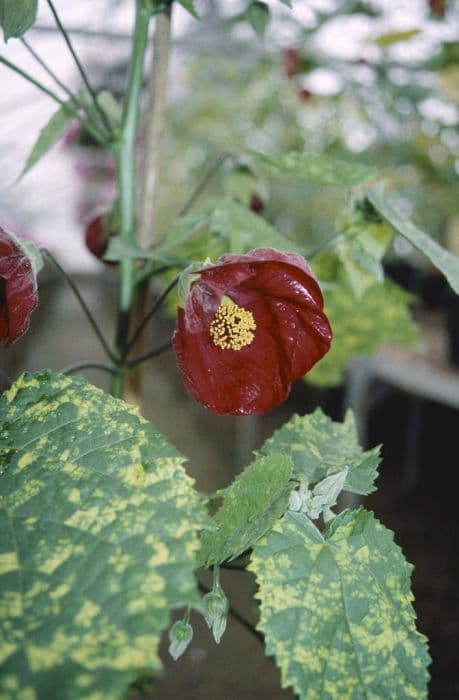
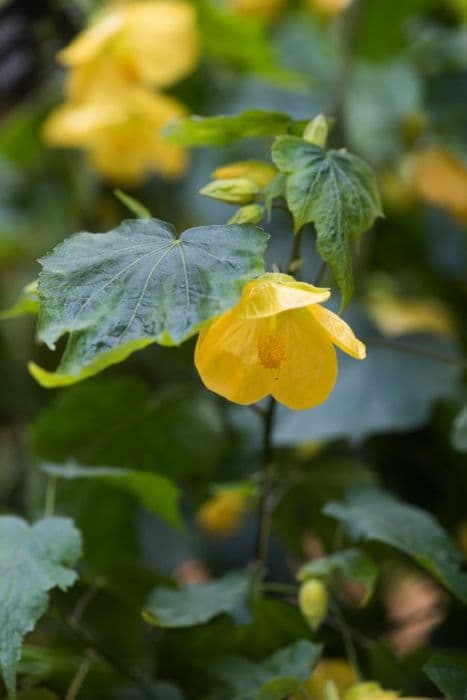
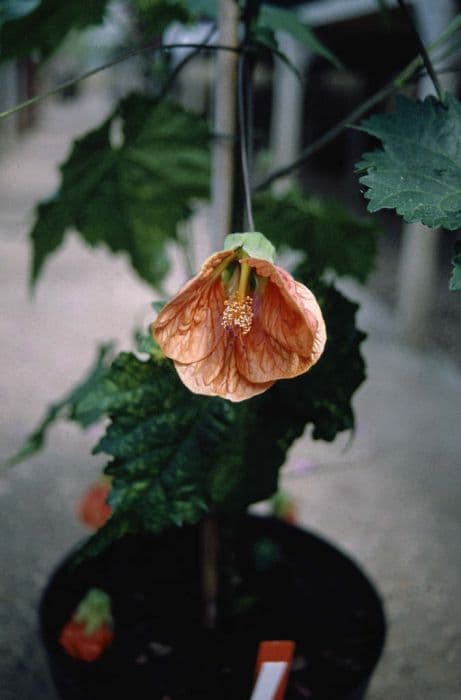
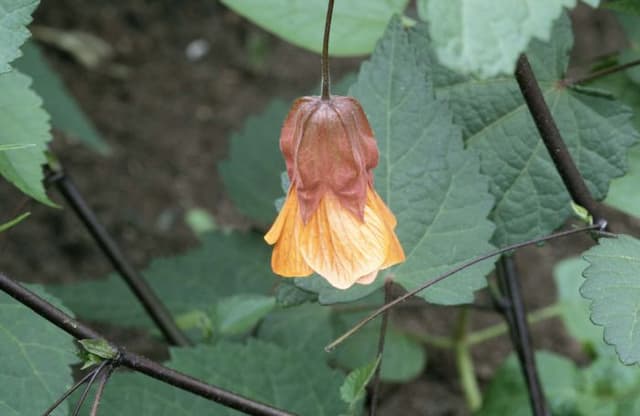

![Abutilon [Yellow Trumpet]](/_next/image?url=https%3A%2F%2Fplants-admin.emdemapps.com%2Fimages%2Fplants%2F%2Fimages%2F604b5caa8b4fb.png&w=640&q=75)


